April 25th, 2018 by
 Diego Riitano
Diego Riitano
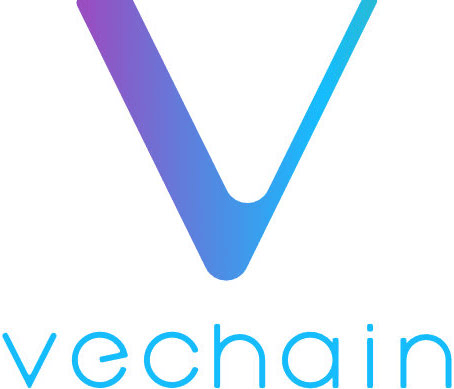
Besides Bitcoin and Ethereum, there are many unique altcoins and tokens.
They all serve different purposes and have different functions.
In fact, well over a thousand different cryptocurrencies exist.
But with so many on the market, how can you decided which coins are worth owning?
The best way to learn about coins is by researching them, and reading guides and reviews.
In this guide, you will learn about Vechain, and how to buy Vechain on Binance. You’ll also learn how to safely store your Vechain.
How to Buy Vechain with USD
You cannot directly purchase Vechain with USD. In order to buy, you must first purchase another cryptocurrency with USD, then trade it for Vechain.
Before Buying Vechain: Purchase Bitcoin or Ethereum
Before buying Vechain, you have to buy Bitcoin or Ethereum first. To learn how to buy Bitcoin, follow our guide.
Step 1: Send to an Exchange
After buying Bitcoin, you need to send it to an exchange that trades Vechain. In this guide, we will be using Binance.
After signing into Binance, look in the upper-right corner, hover over the Funds tab, then select Balances.
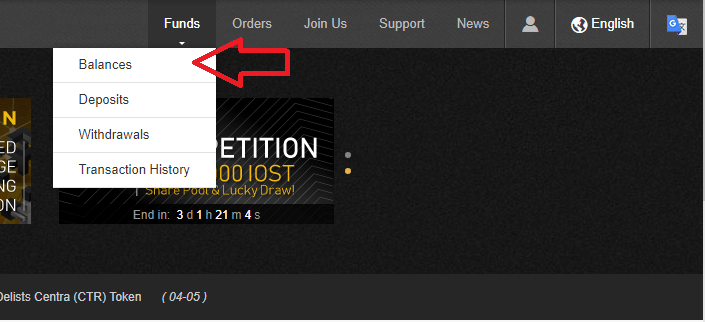
Scroll down to Bitcoin, then click deposit.

Copy your Bitcoin deposit address. Be sure to use your own address, and not the one shown in the picture.
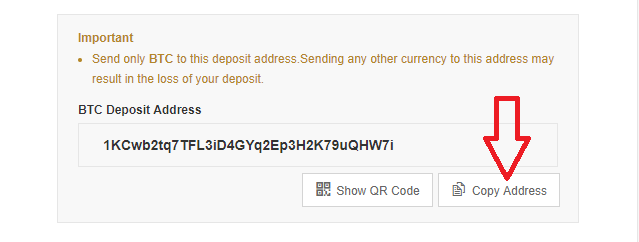
Sign into Coinbase, then select the accounts tab.
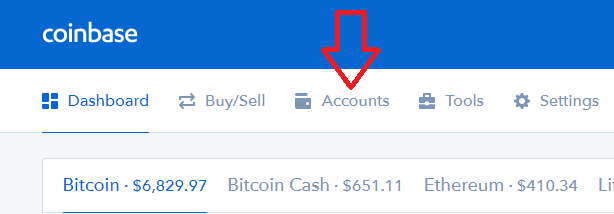
Under your Bitcoin wallet, select the send button.
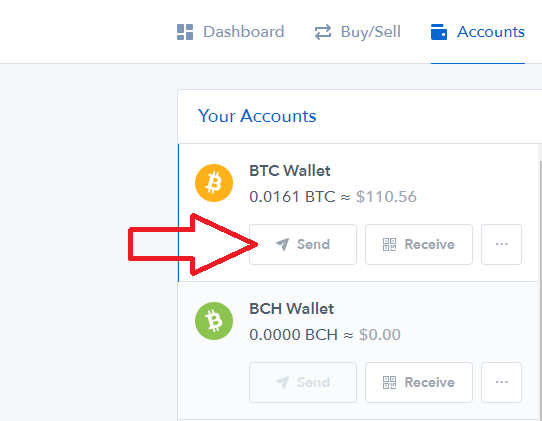
Paste your Binance wallet address in the recipient box. Enter the amount of Bitcoin in dollars that you would like to send, then click continue.
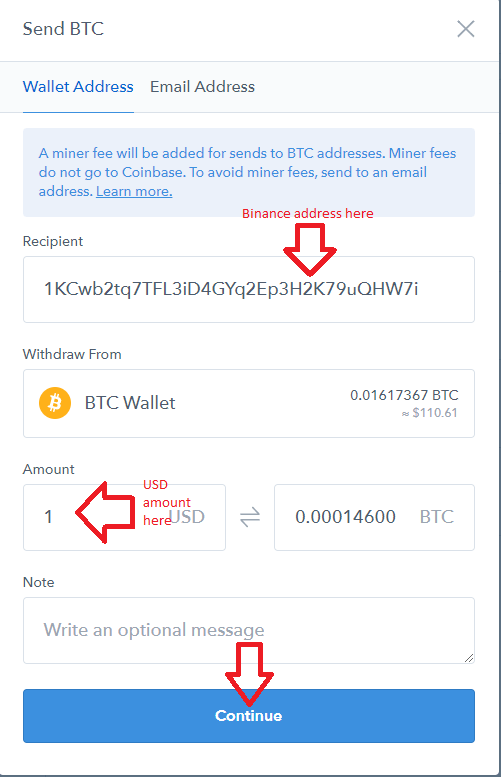
You will then be prompted to confirm your transaction. You will also be shown the miner fee for your transaction. This fee varies, and does not go to Coinbase, but instead to the miners who verify blocks on Bitcoin’s blockchain. If you have 2-factor authentication enabled, you will also be asked to enter your 6-digit verification code.

After you send your Bitcoin, it may take some time to arrive. Don’t panic immediately if your Bitcoin has left Coinbase but not arrived at Binance. Depending on the Bitcoin network and websites themselves, transfers may take some time to process.
Step 2: Buy Vechain
After your Bitcoin transfers to Binance, then you can purchase your Vechain.
Back on the Balances tab, scroll down to Vechain and click Trade. In the dropdown menu, select VEN/BTC.

In the middle of the screen, select the Market tab. In this tutorial, we will be buying Vechain with a market order. There are other types of orders, but market orders are the easiest to use.

Enter the amount of Vechain you would like to buy. The price you pay per Vechain will be shown at the top right in dollars and in Bitcoin. After entering the amount you would like to buy, click Buy VEN. Binance will take a .1% fee from your transaction.
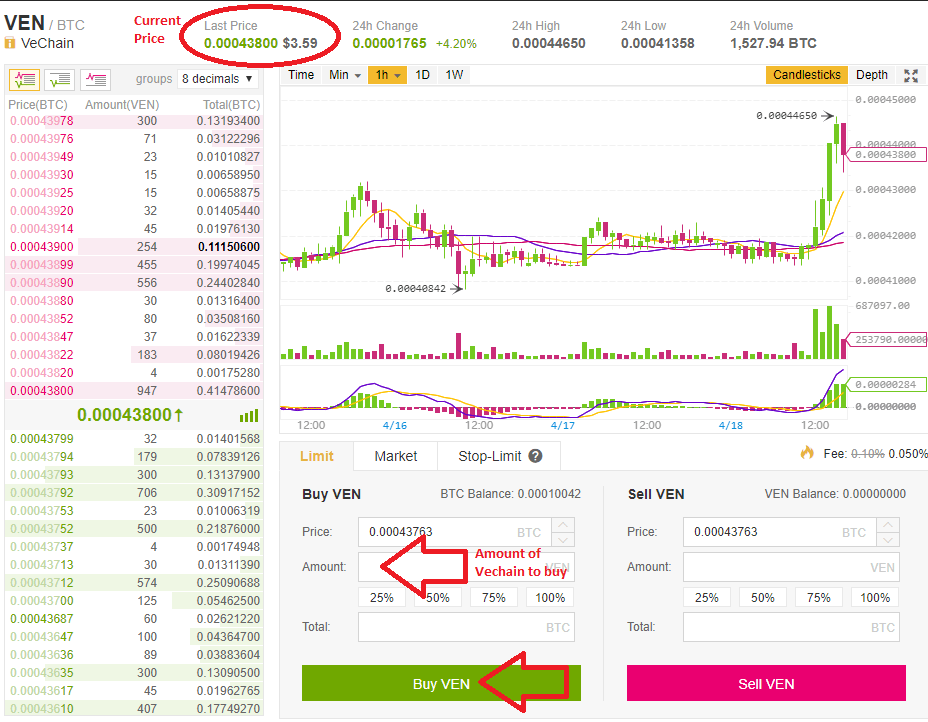
After buying, you should be able to view your Vechain in the balances tab.
Step 3: Safely Store Your Vechain!
Once you buy, your Vechain is stored on the exchange wallet. Although your Vechain has been received, it is not totally secure. Every wallet has a private key, or a sequence of numbers or letters. Each private key is unique to one wallet, and allows access to the contents of that wallet.
If you have Vechain on an exchange wallet, they will control the private keys. This leaves your tokens more vulnerable to manipulation by others. If the exchange is hacked, the hackers will use your private keys to access your Vechain.
Additionally, if an untrustworthy exchange pulls an exit scam, they could walk away with your tokens. While these events may seem unlikely, they have occurred before multiple times.
The best way to store cryptocurrencies is usually a hardware wallet, as they combine security and accessibility. Some cryptocurrencies are unable to be stored in hardware wallets, but Vechain is hardware wallet compatible.

Vechain is an ERC20 token, a type of token based on the Ethereum blockchain. All ERC20 tokens can be stored on hardware wallets, but in order to do so, you must configure your hardware wallet with an ERC20 software wallet. One of the most popular ERC20 software wallets is MyEtherWallet (MEW).
For more information on cryptocurrency wallets, you can check out our guide.
Introduction to Vechain
Vechain is a blockchain product management platform. Vechain uses the blockchain in order to collect, manage, and share product data for better supply chain management.
While you may not realize it, every product you purchase goes through many steps before finally reaching a consumer. At a grocery store for example, each piece of produce is grown somewhere hundreds or thousands of miles away.
After being harvested, the produce then must be shipped through multiple intermediaries. It is sent to a distributor, then from there sent to your grocery store. After arriving, the produce is stocked, where it stays until you finally purchase it.
Throughout this whole process, the produce must be kept at the correct temperature and humidity to ensure it does not spoil. All these steps must be considered in supply chain management.
Vechain attempts to simplify the entire process by incorporating blockchain technology into the supply chain.
Each product on the Vechain network will receive a smart chip. This chip will store and record location data at every step along the way. Additionally, chips can be fitted with other data sensors, such as temperature sensors, to ensure items like produce are not spoiling.
Incorporating blockchain and smart chips into supply chain will save producers and consumers time and money.

Should you Buy Vechain?
If you’ve made it this far, you now know how to buy Bitcoin, use it to buy Vechain, and safely store your Vechain in a wallet.
Before buying though, you should always do your research to make sure the coin you’re purchasing is sound.
Things to look for include how the coin works, use cases, partners, and the team behind the coin.
The sections below are dedicated to giving you the information you need to decide whether Vechain is a coin you’d like to purchase.
The Team
Vechain is led by CEO Sunny Lu. He served as an IT executive in Fortune 500 companies for more than 13 years and is the former CIO of Louis Vuitton China.
Jay Zhang serves as Vechain CFO, and he has been a senior manager at PwC and Deloitte for more than 14 years.
The position of COO is held by Kevin Feng, who has more than 12 years of cybersecurity experience.
Jianliang Gu is the Vechain CTO. He holds a master’s degree in Cybernetics and has more than 16 years of experience in systems development and management.
In total, the core team consists of 10 members.

Vechain is also overseen by members of the Board of Steering Committee, the governing body of the Vechain Foundation.
Additionally, Vechain is backed by Draper Dragon, Fenbushi Capital, and Breyer Capital.
Community
The Vechain community is large and active, and the team delivers news regularly. The Vechain blog posts updates quite often. The Vechain Twitter page has over 90,000 followers. Vechain’s subreddit has more than 46,000 subscribers.
Use Cases
Vechain has many valuable applications in the supply chain management ecosystem. As previously mentioned, Vechain smart chips can be added to products that must remain cold to ensure they remain unspoiled and fit for consumption. However, this is not the only use of the Vechain blockchain.
In the automotive industry, Vechain has many uses as well. Cars can be fitted with data sensors that create a digital passport of that vehicle. This can track data such as repair history, insurance, and registration.
This data is in the hands of the vehicle owner, but it can easily be shared with insurance companies in the case of an accident or other event.
Additionally, these digital passports can provide much more transparency to used car buying. A prospective buyer will be able to see the vehicle’s repair history and can decide whether or not the condition of the vehicle is fit for them.
One use case where transparency is imperative is the medical and healthcare industry. Implants and other medical devices must be held to strict standards to ensure quality and safety for the patient. The addition of Vechain smart chips will make quality assurance much easier.
Smart chips in implants can also be used to monitor biometrics. If the patient desires, they can share this data with their doctor to receive real time health monitoring.

Another major area where Vechain excels is luxury goods and fashion. CEO Sunny Lu is was formerly the CIO of Louis Vuitton China, so he has plenty of experience in this department.
Embedding a chip in luxury goods will help to prevent illegal overstock trading. When a customer plans to buy a luxury item, they can pull out their phone and scan the item.
This simple action will reveal whether an item is authentic or counterfeit. The global counterfeit goods market is 461 billion dollars, but the use of Vechain could eliminate that problem entirely.
Partnerships
Vechain already has many major partnerships.
In 2017, they partnered with Direct Imported Goods (DIG), China’s largest fine wine importer. Vechain placed their smart chips on the top of the bottle. When the bottle is opened, the chip is destroyed, which prevents counterfeiters from filling the bottle with another wine.
The chips can also be used to view the life cycle of the wine, including regulators, distributors, and retailers.
Vechain has also partnered with DNV GL. DNV GL is a $20 billion company that specializes in risk management as well as providing services to maritime, oil and gas, and energy companies. This partnership could provide Vechain with a massive list of clients.
Vechain has also joined the PwC incubator program which will give them access to additional clients. PwC, or PricewaterhouseCoopers is responsible for auditing many of the world’s largest companies, including over 80% of the Fortune Global 500.
The Chinese government selected Vechain to become the blockchain technology partner of the government of Gui’an. Gui’an New Area is a rapidly developing economic zone that has drawn Microsoft, Hyundai, Qualcomm, Alibaba, and others.

Vechain also has more than a dozen other partnerships.
Conclusion
Vechain intends to be the blockchain platform for supply chain management. This large and varied field has many sectors, such as agriculture, luxury goods, and automobiles.
Vechain already has real world usage, and boasts an impressive list of partnerships that only grows by the day. Vechain’s biggest obstacle may be other competitors, such as Waltonchain and Modum.
If Vechain can outpace its competitors, and continue to secure partnerships and real world use cases, it has the potential to become ubiquitious within the supply chain management industry.
NOTE: We are not financial advisors and none of this information should be taken as investment advice. We take no responsibility for any losses incurred through cryptocurrency trading.
